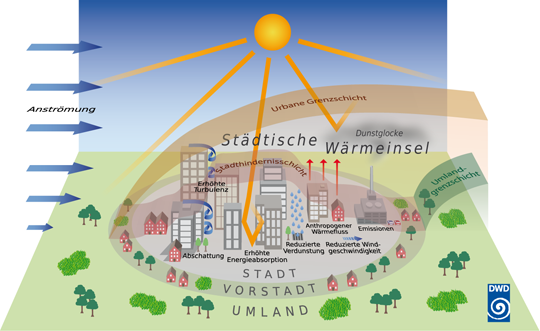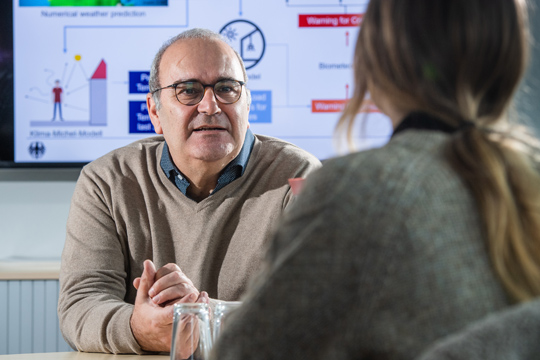The Heat Island and the Weather
Freiburg, Jun 16, 2020
More and more people are living in cities. So architects are having to pay more attention to adapting their plans to climate change. In applied human biometeorology, scientists study the effects of the weather on human health. Drawing on models from medicine, meteorology and climate change they can simulate the outcome of planning and the climate and develop current and future forecasts for alerts and for adaptation planning. Biometeorologist Prof. Dr. Andreas Matzarakis from the University of Freiburg, scientific head of the Research Centre Human Biometeorology for the German weather service in Freiburg, explains in conversation with Francis Heinzler how the climate behaves in cities and what we can do about it.
 Experts assume that cities in the south-west of Germany will get three to four degrees centigrade warmer by the end of this century.
Experts assume that cities in the south-west of Germany will get three to four degrees centigrade warmer by the end of this century.
Photo: Sina Ettmer/stock.adobe.com
Professor Matzarakis, many people can tell in advance when the weather is going to change – is there really such a thing as sensitivity to the weather?
Andreas Matzarakis: We all respond to the weather. That is, for instance, we look out of the window and feel happy because the sun is shining. Just over 50 percent of the population of Germany are ‘wetterfühlig’ or weather sensitive. And they aren’t malingerers who say, “The weather’s bad so I’m feeling poorly,” They have a pre-existing condition such as rheumatism, a respiratory disease or psychological disorder. When an area of low pressure comes, they’re subjected to increased stress. And then there are also ‘wetterempfindliche’ people, who have a longstanding health issue or for example scars after operations. In Germany this affects around 15 to 20 percent of the population. These people sense the weather extremely strongly and can often sense a change in advance. This shows us that it isn’t the traditional factors such as temperature or humidity that trigger these symptoms, but factors that even occur in a sealed room, for instance, sudden, very slight fluctuations in air pressure.
So as a human biometeorologist do you only research the negative effects of the weather?
No, to a large extent both my colleagues and I deal with the positive aspects that the climate has for people. For instance where climatic health resorts or fresh-air health resorts can be found. But there aren’t just researchers who regard the climate as a therapeutic agent and study it. We analyze places where people live in general – and most people live in cities. So many researchers of human biometeorology study city climate and how it affects people.
What makes the climate of a city different from the surrounding area?
Cities are warmer than their surrounding areas because there are far more surfaces in cities, not just horizontal, but also vertical. These surfaces absorb the radiation and reflect it back again. In addition this radiation and the heat is stored for longer by the material of the surfaces in cities. So there’s a lot of radiation in the daytime that’s not released at night. Along with other factors such as more pollutants in the air this leads to the well-known phenomenon of urban heat islands. Annually on average this makes a city about two or three degrees centigrade warmer than the surrounding area.
 Heat island: The World Meteorological Organization (WMO) defines the city climate as ‘a local climate that differs from its surrounding climate due to effects of buildings and emissions’. Source: Deutscher Wetterdienst
Heat island: The World Meteorological Organization (WMO) defines the city climate as ‘a local climate that differs from its surrounding climate due to effects of buildings and emissions’. Source: Deutscher Wetterdienst
Does climate change reinforce this effect?
Yes, we’re expecting that cities in the south-west of Germany will get three to four degrees centigrade warmer by the end of this century. This means that people in the cities are already experiencing climate change and in future they will have climate change twice: firstly in the urban climate and secondly in global climate change. So here especially we must push ahead with reducing the causes and work to adapt suitably.
What form can this take?
It’s important to create oases within the city where people can relax. You can achieve a lot with just a few trees, depending on how the trees are located. But even by orienting the buildings in the right way and adapting their height, so that there are fewer vertical surfaces, or by greening facades and roofs you can reduce the heat in cities. So biometeorologists are working closely with city planning departments. For example we’re studying surfaces along a road, Gerberau in Freiburg. If I place my hand on a greened facade there, I can directly feel the difference compared to a facade without such planting. Also in Freiburg we’re studying whether the fresh breeze that comes from Höllental valley can pass through the city freely. As researchers we’re now finding that it’s ‘in’ for cities not only to declare a climate emergency, but also to develop heat action plans.
 It’s important to create relaxing oases within the city – you can achieve a lot with just a few trees, says Andreas Matzarakis. Photo: Klaus Polkowski
It’s important to create relaxing oases within the city – you can achieve a lot with just a few trees, says Andreas Matzarakis. Photo: Klaus Polkowski
So what are heat action plans?
The goal of heat action plans is to avoid heat and UV-related diseases and deaths by adapting city planning and structural design. In addition the plans would take effect in acute situations like a heat wave warning system. Based on this there would be an official warning when temperatures cause health stresses.
What should we all do if there is a heat wave warning?
The recommendations are to drink plenty of liquids, keep indoor rooms cool and avoid the sun. Under extreme heat stress there is a fourth recommendation: at this stage people are asked not only to take care of themselves but also to look out for others.

